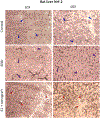Dependence between estrogen sulfotransferase (SULT1E1) and nuclear transcription factor Nrf-2 regulations via oxidative stress in breast cancer
- PMID: 32449069
- PMCID: PMC9248037
- DOI: 10.1007/s11033-020-05518-z
Dependence between estrogen sulfotransferase (SULT1E1) and nuclear transcription factor Nrf-2 regulations via oxidative stress in breast cancer
Abstract
Human estrogen sulfotransferase (SULT1E1) and nuclear factor erythroid 2-related factor 2 (Nrf-2) expression influences each other in advanced human breast carcinogenesis. The difference in the metabolism of estradiol (E2) in pre- and post-menopausal women remains to be connected with post-menopausal breast cancer. A synergism between ROS production and E2 generation has been demonstrated. No definite mechanism for simultaneous functions of Nrf2, oxidative stress E2 regulating enzymes (SULT1E1) has been yet clarified. Our present review demonstrates that ROS dependent regulation of Nrf-2 is one of the most important determinants of E2 regulation by altering SULT1E1 expression. This study also focuses the idea that estrogen receptor cased subtypes of cancer may have different molecular environments which has an impact on the therapeutic efficacy.
Keywords: Breast cancer; Estrogen regulations; Nrf-2 and SULT1E1 expressions; Oxidative stress.
Conflict of interest statement
Figures



Similar articles
-
Oxidant stress induction and signalling in xenografted (human breast cancer-tissues) plus estradiol treated or N-ethyl-N-nitrosourea treated female rats via altered estrogen sulfotransferase (rSULT1E1) expressions and SOD1/catalase regulations.Mol Biol Rep. 2018 Dec;45(6):2571-2584. doi: 10.1007/s11033-018-4425-z. Epub 2018 Oct 12. Mol Biol Rep. 2018. PMID: 30315444
-
Breast cancer pathogenesis is linked to the intra-tumoral estrogen sulfotransferase (hSULT1E1) expressions regulated by cellular redox dependent Nrf-2/NFκβ interplay.Cancer Cell Int. 2020 Mar 4;20:70. doi: 10.1186/s12935-020-1153-y. eCollection 2020. Cancer Cell Int. 2020. PMID: 32158360 Free PMC article.
-
Estrogen sulfotransferase (SULT1E1) regulates inflammatory response and lipid metabolism of human endothelial cells via PPARγ.Mol Cell Endocrinol. 2013 Apr 30;369(1-2):140-9. doi: 10.1016/j.mce.2013.01.020. Epub 2013 Feb 4. Mol Cell Endocrinol. 2013. PMID: 23384540
-
Estrogen sulfotransferase in the metabolism of estrogenic drugs and in the pathogenesis of diseases.Expert Opin Drug Metab Toxicol. 2019 Apr;15(4):329-339. doi: 10.1080/17425255.2019.1588884. Epub 2019 Mar 18. Expert Opin Drug Metab Toxicol. 2019. PMID: 30822161 Free PMC article.
-
New development in intracrinology of breast carcinoma.Breast Cancer. 2006;13(2):129-36. doi: 10.2325/jbcs.13.129. Breast Cancer. 2006. PMID: 16755106 Review.
Cited by
-
Contribution of n-3 Long-Chain Polyunsaturated Fatty Acids to the Prevention of Breast Cancer Risk Factors.Int J Environ Res Public Health. 2022 Jun 28;19(13):7936. doi: 10.3390/ijerph19137936. Int J Environ Res Public Health. 2022. PMID: 35805595 Free PMC article. Review.
-
Do Lifestyle Interventions Mitigate the Oxidative Damage and Inflammation Induced by Obesity in the Testis?Antioxidants (Basel). 2025 Jan 27;14(2):150. doi: 10.3390/antiox14020150. Antioxidants (Basel). 2025. PMID: 40002337 Free PMC article. Review.
-
Development and validation of ferroptosis-related lncRNA signature and immune-related gene signature for predicting the prognosis of cutaneous melanoma patients.Apoptosis. 2023 Jun;28(5-6):840-859. doi: 10.1007/s10495-023-01831-7. Epub 2023 Mar 24. Apoptosis. 2023. PMID: 36964478
-
Dialyl-sulfide with trans-chalcone prevent breast cancer prohibiting SULT1E1 malregulations and oxidant-stress induced HIF1a-MMPs induction.Genes Cancer. 2024 Aug 9;15:41-59. doi: 10.18632/genesandcancer.237. eCollection 2024. Genes Cancer. 2024. PMID: 39132498 Free PMC article.
-
Curculigoside mitigates dextran sulfate sodium‑induced colitis by activation of KEAP1‑NRF2 interaction to inhibit oxidative damage and autophagy of intestinal epithelium barrier.Int J Mol Med. 2023 Nov;52(5):107. doi: 10.3892/ijmm.2023.5310. Epub 2023 Sep 29. Int J Mol Med. 2023. PMID: 37772380 Free PMC article.
References
-
- Motohashi H, Yamamoto M (2004) Nrf2-Keap1 defines a physiologically important stress response mechanism. Trends Mol Med 10:549–557 - PubMed
-
- Klaassen CD, Slitt AL (2005) Regulation of hepatic transporters by xenobiotic receptors. Curr Drug Metab 6:309–328 - PubMed
-
- Mandlekar S, Hong JL, Kong AN (2006) Modulation of metabolic enzymes by dietary phytochemicals: a review of mechanisms underlying beneficial versus unfavorable effects. Curr Drug Metab 7:661–675 - PubMed
Publication types
MeSH terms
Substances
Grants and funding
LinkOut - more resources
Full Text Sources
Medical
Research Materials

